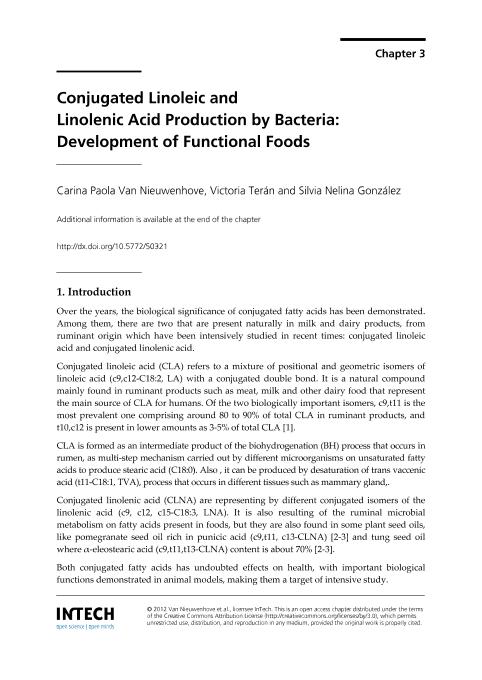Capítulo de Libro
Conjugated linoleic and linolenic acid production by bacteria: development of functional foods
Título del libro: Probiotics
Van Nieuwenhove, Carina Paola ; Terán, Victoria
; Terán, Victoria ; Gonzalez, Silvia Nelina
; Gonzalez, Silvia Nelina
 ; Terán, Victoria
; Terán, Victoria ; Gonzalez, Silvia Nelina
; Gonzalez, Silvia Nelina
Otros responsables:
Rigobelo, Everlon
Fecha de publicación:
2012
Editorial:
IntechOpen
ISBN:
978-953-51-0776-7
Idioma:
Inglés
Clasificación temática:
Resumen
Over the years, the biological significance of conjugated fatty acids has been demonstrated. Among them, there are two that are present naturally in milk and dairy products, from ruminant origin which have been intensively studied in recent times: conjugated linoleic acid and conjugated linolenic acid. Conjugated linoleic acid (CLA) refers to a mixture of positional and geometric isomers of linoleic acid (c9,c12-C18:2, LA) with a conjugated double bond. It is a natural compound mainly found in ruminant products such as meat, milk and other dairy food that represent the main source of CLA for humans. Of the two biologically important isomers, c9,t11 is the most prevalent one comprising around 80 to 90% of total CLA in ruminant products, and t10,c12 is present in lower amounts as 3-5% of total CLA [1]. CLA is formed as an intermediate product of the biohydrogenation (BH) process that occurs in rumen, as multi-step mechanism carried out by different microorganisms on unsaturated fatty acids to produce stearic acid (C18:0). Also , it can be produced by desaturation of trans vaccenic acid (t11-C18:1, TVA), process that occurs in different tissues such as mammary gland,. Conjugated linolenic acid (CLNA) are representing by different conjugated isomers of the linolenic acid (c9, c12, c15-C18:3, LNA). It is also resulting of the ruminal microbial metabolism on fatty acids present in foods, but they are also found in some plant seed oils, like pomegranate seed oil rich in punicic acid (c9,t11, c13-CLNA) [2-3] and tung seed oil where α-eleostearic acid (c9,t11,t13-CLNA) content is about 70% [2-3]. Both conjugated fatty acids has undoubted effects on health, with important biological functions demonstrated in animal models, making them a target of intensive study. Over the years, CLA has received great attention due to their beneficial properties on health. There exist near 28 different CLA isomers produced by natural and industrial process during fatty acid hydrogenation [4], but the most important according to their biological effects are c9, t11 and t10,c12 forms. However, CLA isomer in milk fat according to importance are c9,t11 (around 80%) followed by t7,c9, which is quantitatively the second most important reaching level so high as 3 to 16 % of total CLA [5]. Factors affecting CLA content in milk, such as the food of ruminants [6-7], the animal breeding type and the stage of lactation [8] were widely reported. Many studies demonstrated the action of CLA as anti-carcinogenic [9], anti-diabetic [10] and immune-modulator [11] compound. Although there is no agreement regarding its function on fat metabolism, some authors revealed that its consumption also decreases the fat deposition [12]. In addition, CLA produced trough chemical isomerization of LA is offer as dietary supplement in many countries. However, unexpected isomers are produced by this process. To consider CLA as a nutraceutical or medicinal compound, a selective isomer production must be done. On the other hand, CLNA showed anti-carcinogenesis effects in vitro and in vivo models [9, 13-14] and other isomers were reported as hypolipidemic compound in human liver derived HepG2 cells [15]. Moreover, it was demonstrated that CLNA exhibits stronger cytotoxic effect on tumoral cells than CLA isomers [16]. Since the most important sources of both conjugated fatty acids for human consumption are milk and dairy products, and due to the microbial production of these compounds, several attempts are being developed to increase its content in food using natural process for it production. In the field of human and animal health, it is interesting to understand the potential beneficial role of selection of bacteria with the ability to form conjugated fatty acids to be then included in foods. Thus, the processed products could be considered as functional foods and sometimes as probiotics, as we detailed below.
Palabras clave:
CLA
,
CLNA
,
PROBIOTICOS
,
ALIMENTOS
Archivos asociados
Licencia
Identificadores
Colecciones
Capítulos de libros(CERELA)
Capítulos de libros de CENTRO DE REFERENCIA PARA LACTOBACILOS (I)
Capítulos de libros de CENTRO DE REFERENCIA PARA LACTOBACILOS (I)
Citación
Van Nieuwenhove, Carina Paola; Terán, Victoria; Gonzalez, Silvia Nelina; Conjugated linoleic and linolenic acid production by bacteria: development of functional foods; IntechOpen; 2012; 55-80
Compartir
Altmétricas



